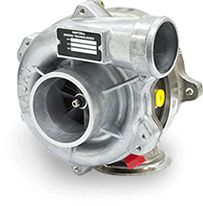Getting My Turbochargers To Work
Table of ContentsSome Known Factual Statements About Turbochargers Turbochargers Fundamentals ExplainedGetting The Turbochargers To Work

For example, in Opel bi-turbo Diesel, only the smaller sized turbocharger works at low speed, providing high torque at 1,5001,700 rpm - turbochargers. Both turbochargers operate together in mid range, with the smaller sized one pre-compressing the air, which the bigger one further compresses. A bypass valve regulates the exhaust circulation to each turbocharger.
Smaller turbochargers have less turbo lag than bigger ones, so frequently 2 small turbochargers are used instead of one large one. This setup is popular in engines over 2. 5-litres and in V-shape or boxer engines. Twin-scroll or divided turbochargers have 2 exhaust gas inlets and 2 nozzles, a smaller sharper angled one for quick response and a larger less angled one for peak performance.
In twin-scroll styles, the exhaust manifold physically separates the channels for cylinders that can hinder each other, so that the pulsating exhaust gasses circulation through different spirals (scrolls). With typical firing order 1342, two scrolls of unequal length pair cylinders 1 and 4, and 3 and 2. This lets the engine effectively utilize exhaust scavenging strategies, which reduces exhaust gas temperatures and emissions, improves turbine efficiency, and lowers turbo lag apparent at low engine speeds.
The vanes are positioned simply in front of the turbine like a set of somewhat overlapping walls. Their angle is changed by an actuator to block or increase air circulation to the turbine. This irregularity preserves a comparable exhaust velocity and back pressure throughout the engine's rev range. The result is that the turbocharger improves fuel performance without a noticeable level of turbocharger lag.
The compressor is made up of an impeller, a diffuser and a volute real estate. The operating series of a compressor is explained by the "compressor map". The flow variety of a turbocharger compressor can be increased by permitting air to bleed from a ring of holes or a circular groove around the compressor at a point a little downstream of the compressor inlet (but far nearer to the inlet than to the outlet).
See This Report on Turbochargers
It attains this by requiring a simulation of impeller stall to happen continually. Enabling some air to leave at this place hinders the onset of rise and expands the operating variety. While peak effectiveness might decrease, high performance might be attained over a greater variety of engine speeds. Boosts in compressor efficiency lead to somewhat cooler (more thick) consumption air, which improves power.
The capability of the compressor to supply high boost at low rpm may also be increased marginally (because near choke conditions the compressor draws air inward through the bleed path). Ported shrouds are utilized by lots of turbocharger makers. The centre center rotating assembly (CHRA) houses the shaft that connects the compressor impeller and turbine.

Ball bearings created to support high speeds and temperatures are often utilized rather of fluid bearings to support the turbine shaft. This assists the turbocharger accelerate quicker and minimizes turbo lag. Some variable nozzle turbochargers use a rotary electric actuator, which utilizes a direct stepper motor to open and close the vanes, instead of pneumatic controllers that run based on air pressure.
When the pressure of the engine's consumption air is increased, its temperature level likewise increases. This incident can be explained through Gay-Lussac's law, stating that the pressure of a provided amount of gas held at consistent volume is directly try this site proportional to the Kelvin temperature. With more pressure being contributed to the engine through the turbocharger, overall temperatures of the engine will likewise rise.
The warmer the consumption air, the less dense, and the less oxygen available for the combustion occasion, page which reduces volumetric effectiveness. Not only does extreme intake-air temperature level reduce performance, it likewise causes engine knock, or detonation, which is harmful to engines. To compensate for the increase in temperature level, turbocharger systems often make usage of an intercooler in between successive phases of boost to cool off the intake air.
The Of Turbochargers
There are 2 areas on which intercoolers are typically installed. turbochargers. It can be either installed on top, parallel to the engine, or installed near the lower front of the lorry. Top-mount intercoolers setups will lead to a decline in turbo lag, due in part by the place of the intercooler being much closer to the turbocharger outlet and throttle body.
Front-mount intercoolers can have the prospective to provide much better cooling compared to that of a top-mount. The area in which a top-mounted intercooler is located, is near among the hottest locations of a car, right above the engine. This is why most makers consist of large hood scoops to help feed air to the intercooler while the vehicle is moving, but while idle, the hood scoop provides little to no advantage.
With more range to take a trip, the air circulated through a front-mount intercooler may have more time to cool. Methanol/water injection has been around given that the 1920s however he has a good point was not used up until The second world war. Adding the mixture to consumption of the turbocharged engines reduced operating temperature levels and increased horse power.